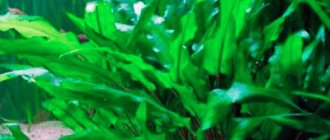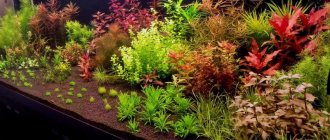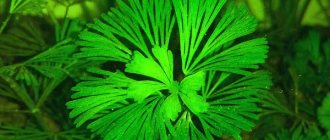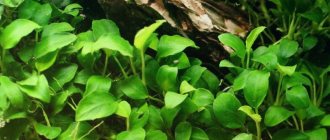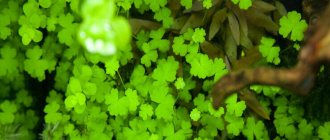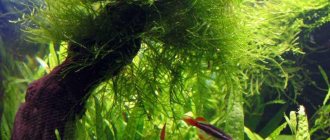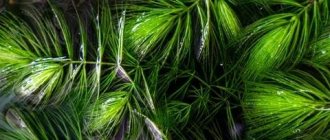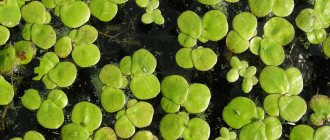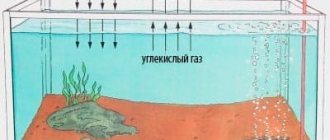Classification and description
Echinodorus tender belongs to the family of chastuchova and the class of monocotyledons. The leaves have a rich green color, their shape is elongated, up to 5 cm long. The maximum height of the bushes is 10 cm. The leaf blades are quite narrow (no more than 0.5 cm), widening towards the middle, narrow at the roots and pointed towards the top.
A related plant of the Dwarf Amazon is Echinodorus rubra. The differences between these two plants are that the rubra is taller than the Amazon, its bush can grow up to 17 cm, the leaves are thinner, and their color is purple.
Origin and description
The plant is native to South America, although it is also found in North America. Under natural conditions it grows in shallow bodies of clean fresh water, such as a river or lake. Not found in the wild in Eurasia.
Echinodorus tenellus can be called a ground cover plant - it quickly develops with small ground shoots and quickly covers the space allotted to it . In aquarium keeping it is used to form a lawn in the foreground.
Echinodorus tenellus var parvulus belongs to the Chasticaceae family and is considered its shortest representative: the maximum height is 10 cm, but rarely exceeds 5-6 cm. Under natural conditions, Echinodorus can grow up to 20-30 cm, it all depends on the degree of illumination and transparency of the water.
The leaves of the plant are lanceolate and pointed upward. At the root, the leaves are collected in a small rosette. Their width is on average 3-5 mm. Bright green leaves, shimmering with emerald, are the main feature of the plant. In the wild, hue is determined by water temperature and can range from light green to rich dark tones.
There is a more hardy variety of Echinodorus tender - rubra. It differs in that young leaves are not bright green, but purple, but there is still a green or pink stripe down the middle of the leaf.
Habitat
Echinodorus tender comes from fresh waters, which is why it is used by aquarium enthusiasts. Distribution area: America. The favorite place of this aquarium plant is shallow reservoirs, rivers and lakes with a shallow bottom. Dwarf Amazons are clean creatures, picky about the quality of the water in which they live, so they can only be found in those reservoirs that are distinguished by the purity and transparency of the water.
The peculiarity of this plant is that it can change the color and degree of saturation of the shade of its leaves, depending on how illuminated the water is by sunlight. Leaves may turn pale due to low water temperatures. Gentle Echinodorus will respond to heat with a rich green color.
Echinodorus tender how to grow
Echinodorus tender tenellus photo
Range – North and South America. Echinodorus tenellus, also known as the herbaceous Echinodorus, is a herbaceous plant of the genus Echinodorus of the family Partisaceae, also known among aquarists as the “dwarf Amazon”.
Thickets of Echinodorus tender are 7-10 cm high. Echinodorus tender is popular among aquarists due to its unpretentiousness to living conditions and high decorative qualities.
Echinodorus tender tenellus photo
Comfortable water parameters for keeping Echinodorus tender : temperature 24-26 ° C, hardness - more than 4 °, Echinodorus feels better in a neutral and slightly alkaline environment. It is advisable to change the water regularly.
This echinodorus requires powerful lighting from 70 Lm/l, at which the plant acquires a bright color, the bushes become low and dense. The duration of daylight hours is from 8 to 12 hours, depending on the power of the illuminators.
Echinodorus tender tenellus photo
Tenellus grows well in nutritious soil. The substrate is coarse sand. A layer of soil from 3 cm. Mineral fertilizing is required only in a very densely planted aquarium.
Reproduction is easy. The mother bush forms 2-3 tendrils, on which young plants appear one after another. Such a mustache can be separated and planted in a new place.
PS It is worth distinguishing Echinodorus tenellus from rubra - these are two different plants.
Echinodorus gentle video review
Video about plants from FanFishki
Subscribe to our YouTube channel so you don't miss anything
PRACTICAL NOTE ON GROWING AQUARIUM PLANTS
This note is posted in all FanFishka articles dedicated to aquarium plants. This is a cheat sheet with a link that will help you grow any aquarium plant and herbalist of any complexity.
Most of the reference materials are located in the Aquascape , we also recommend our brochure: Aquarium navigator for beginners: “Underwater Gardens of Babylon” .
The formula for success in growing plants can be depicted as follows.
First of all, the proper level of lighting is necessary.
(light intensity - Lumens)
Next, the proper concentration of CO2
Further macro-fertilizers and micro-fertilizers
Water parameters, care and quality water changes
Content Features
Such a wide distribution and love of aquarists for Echinodorus tender is explained by the fact that the plant not only serves as a bright decoration for the glass abode of fish, but is also easy to care for and not picky. The main condition for maximum growth, development and beauty of leaves is clean water and good lighting.
Since the delicate Echinodorus needs warm sunlight, it is suitable for small aquariums, the height of the walls should not be more than 25 cm. Otherwise, it will be difficult for the sun's rays to penetrate through large layers of water. It is recommended to trim the bushes periodically as they grow, this will help you quickly achieve a dense green carpet over the entire aquarium bottom.
Priming
The Dwarf Amazon loves muddy litter, but with a moderate thickness of 1-3 cm. The short and fragile roots of the delicate plant do not require thick soil. Therefore, stones are not very suitable, because of which the echinodorus will unevenly cover the bottom, and this will greatly spoil its decorative purpose.
Ideal environment
The dwarf Amazon does not require maintaining a single chemical composition of the liquid. The main thing is that the water temperature is moderately warm. Ideal temperature conditions for the plant are from +22 to +25°C. Cold water slows down the growth of the plant and interferes with the synthesis process, which causes the death of the plant.
If you want to please your fish with a beautiful and delicate lining of the aquarium, you should remember that gentle Echinodorus needs a certain water hardness, which should be in the range from 6 to 16 Dh. In addition, you need to take care of the acidity of the environment – 6-8 Ph. If the water is very soft, this will lead to a rapid reduction in volume of the bushes and they will become sparse.
The ideal environment for Echinodorus tender is clean water. If you do not regularly clean the aquarium and change the water, the plant will simply die.
You only need to change the water in parts, no more than 1/3 of the total volume at a time. Moreover, such a procedure should be carried out once a week.
How to arrange lighting
Echinodorus tender is a bright, interesting and memorable plant with its unusual leaf blades, and therefore will not hide its beauty in the dark. Aquarium culture needs lighting, both natural sunlight and artificial light.
Sunlight is preferable, but it should not be targeted, but diffused. The best option for dispersing sunlight is an obstacle between the aquarium and the sun in the form of a thin curtain. When there is no sun, artificial light should be supplied using a lamp with a power of 0.5 W/l.
If there is insufficient lighting, the leaves will quickly fade, their shape will also change - they will become more elongated, the leaf blade will decrease in width. The daily duration of lighting should not be less than 12 hours.
Filtration
Clean filtered water is the guarantee that Echinodorus tender will grow well, develop and delight both the fish and the owner of the aquarium. The impossibility of a plant staying in muddy water is explained by the fact that sunlight will not pass through such a liquid in sufficient quantities.
The plant is not tall, so the rays need to pass completely so that they can reach the entire surface of the leaves. This can only be achieved with clean water. In addition, there should also be no greasy film, food residues or other floating algae on the surface of the water.
Compatibility with other types
It gets along well with other plants that are not significantly taller than it. Tall, lush species or plants floating on the surface of the water can destroy a plant such as Echinodorus, as they will shade low bushes from sunlight and artificial light. Coexistence with higher species is only possible if lateral lighting is provided for Echinodorus.
Echinodorus tender does not need additional feeding with minerals. The plant will absorb everything it needs from silted soil or from fish food. Additional nutrition is required only if the plant is damaged or has been left for a long time in conditions unsuitable for this species.
In an aquarium, Echinodorus tender reproduces vegetatively. 2-3 weeks after transplanting the plant into the aquarium, with good soil and sufficient lighting, the plant bush produces several tendrils with new young shoots. It is recommended to separate the daughter shoots from the mother after the formation of 3-5 leaves. After separation, it is necessary to place the new shoot in the ground for further growth. In addition to vegetative propagation, it is capable of dispersing seeds, which grow well in silty soil saturated with minerals.
How to plant correctly
When planting a plant, you need to follow certain rules:
- preparing bedding that silts well. In this case, sifted sand is ideal;
- mineral supplements and nutrients - optional, but not required. If they are used, then in limited quantities;
- mandatory quarantine before planting in the aquarium.
What is quarantine before disembarkation? Echinodorus tender is planted in a separate container in the soil that will be used in the aquarium; the plant needs to be kept in quarantine for 7 days. This is necessary in order to avoid infection of all aquarium crops and inhabitants in case of any lesions or diseases.
There are two options for planting the Dwarf Amazon:
- Immediately before planting, a small excavation is made in the soil of the aquarium, very shallow. The rhizome of the plant is carefully placed in it.
- The second option is to take the plant on a spatula or with your hands along with the soil in which Echinodorus tenderus was planted during quarantine. This method of planting is considered more preferable, since during a week-long quarantine the plant has time to take root and absorb all the beneficial microelements. And planting in a new environment, although identical, will still be stressful for the plant.
It is best to plant tender Echinodorus close to the walls, this will provide the best lighting necessary for the active growth and development of the plant.
Description
The stem is missing. The leaves emerge from one whorl. The leaves are elongated and pointed. The whorls are tapered. The color is light green, rich.
The root system is moderately developed. Ground cover, in aquariums they grow up to 10 cm (typically 6–7 cm). Width - up to 5 mm. They form thickets: a refuge for fry.
Grows in moist soil in greenhouses. Resistant to trampling. It flowers, pollinates and produces seeds. Germinate in sand watered with water.
Lifespan
Not detected due to active reproduction.
Kinds
The genus Echinodorus unites a lot of natural and bred species. The conditions for keeping Echinodorus are similar.
- Echinodorus tenellus rubra with blade-shaped, pointed leaves measuring 100 x 2 mm. No stem, only one whorl. The color is purple with a reddish or bright green stripe. The lighting is intense.
- Large Echinodorus (Echinodorus major) with elongated elliptical leaves. The color is light green with light veins. Grows up to 65–75 cm. Cultivated in deep containers. The lighting is intense.
- Echinodorus bleheri, a yarrow with rounded, pointed leaves. Densely planted, they create shade over a large area. The color is light green with light veins. It reaches 35–45 cm in length. The lighting is standard, diffused.
Compatibility with other aquarium cultures
Echinodorus tender gets along well with other types of aquarium plants. The main thing is that they do not greatly exceed the height of the Dwarf Amazon. Plants that are tall or floating on the surface of the water will block the passage of sunlight, and this will have a detrimental effect on Echinodorus.
The Dwarf Amazon will coexist normally with tall plants only if it is planted directly next to the aquarium walls, which will provide optimal side lighting.
Diseases, their treatment and prevention
This type of aquarium plant is quite resistant to diseases and can only be exposed to them due to human negligence. So, it was already mentioned earlier that too much lighting can cause leaf burns. To avoid this, you need to take the choice of a place for an aquarium and lamps for artificial lighting seriously.
Also, carefully select the fish for your aquarium to exclude those species that like to eat plant leaves. If the aquarium is infected with a fungus, the Amazon bush should be temporarily transplanted into a separate container, having first washed the rhizome from the contaminated soil. Since such procedures are very stressful for the plant, it is advisable to fertilize the new soil with microelements.
Nutrition
For Echinodorus, you do not need to use any mineral supplements or vitamins. The plant takes all the nutrients necessary for growth and reproduction from the soil. A large number of additional feeds can only harm the plant.
The need to use additional sources of minerals appears only when Echinodorus tender will be in an environment for a long time that is not entirely suitable for its existence. For example, if there are temporary difficulties in ensuring sufficient lighting or cleanliness of aquarium waters.
Diseases and methods of their treatment
Echinodorus tender, as a rule, is not prone to any diseases. Only a person can have a negative impact on it by violating the rules for caring for or planting a plant.
If the lighting is too bright (powerful lamps or the aquarium is placed on a windowsill where there is direct access to sunlight), the delicate and lush green leaf plates of the Dwarf Amazon will get burned and instantly turn yellow, photosynthesis will not be able to occur normally in them, resulting in the plant may die.
The incorrect choice of soil litter will also have a negative impact on the condition and appearance of the plant. No matter how beautiful the pebbles look at the bottom of the aquarium, they are not suitable for planting Echinodorus.
The ideal soil for Echinodorus is only sifted river sand.
An attempt to combine a rocky bottom and a Dwarf Amazon will lead to the gradual death of the plant. Echinodorus tender has very delicate and small roots that are simply not able to entwine stones. As a result, the plant will develop unevenly; bushes will spread only in those areas of the aquarium where there are gaps between the stones.
Another danger for the Dwarf Amazon is aquarium inhabitants whose diet includes the leaves of these plants. Vegetarian aquarium inhabitants will eat leaves, even if they receive food in a timely manner.
Irregular cleaning of the aquarium and mixing of different types of plants can lead to the development of fungus, which poses a threat to the Pygmy Amazon. Therefore, if a fungus appears in the aquarium, Echinodorus tender should be immediately quarantined with thoroughly washed soil.
Although quarantine will save Echinodorus, the procedure of removing it from its usual habitat is very stressful. Therefore, in this case, it is necessary to use additional mineral supplements and vitamin fertilizers. Such additives are also used for the soil in the aquarium, where the plant will be planted after getting rid of the fungus.
Lifespan
An aquarist who follows all the rules and recommendations for planting and caring for Echinodorus tenderus will admire the beautiful, bushy carpet at the bottom of the aquarium for a whole year. Under favorable conditions, the mother bush will give life to “daughters”, and the “daughters”, in turn, will be able to take root and turn into mother bushes, giving life to the next branches.
The correct temperature and degree of water density, cleanliness and regular lighting ensure the uninterrupted process of growth and reproduction of Echinodorus tender.
One bush of Dwarf Amazon costs about 150 rubles.
For medium-sized aquariums, it is enough to purchase 2-3 bushes, and with proper care they will quickly multiply and cover the entire bottom.
It is recommended to purchase the plant only in stores that specialize in products for aquariums. If you buy an Echinodorus from hand, there is a chance that it has been in unfavorable conditions and has been weakened, and this will affect the appearance and growth of the plant. There is also a risk that the leaves of the plant will contain pathogenic bacteria and parasites with uncontrolled development.
No matter how high-quality the purchased plant is, only proper care - clean water, lighting and optimal temperature - will create the most favorable conditions under which Echinodorus tender will develop well and delight with its thick green carpet.
